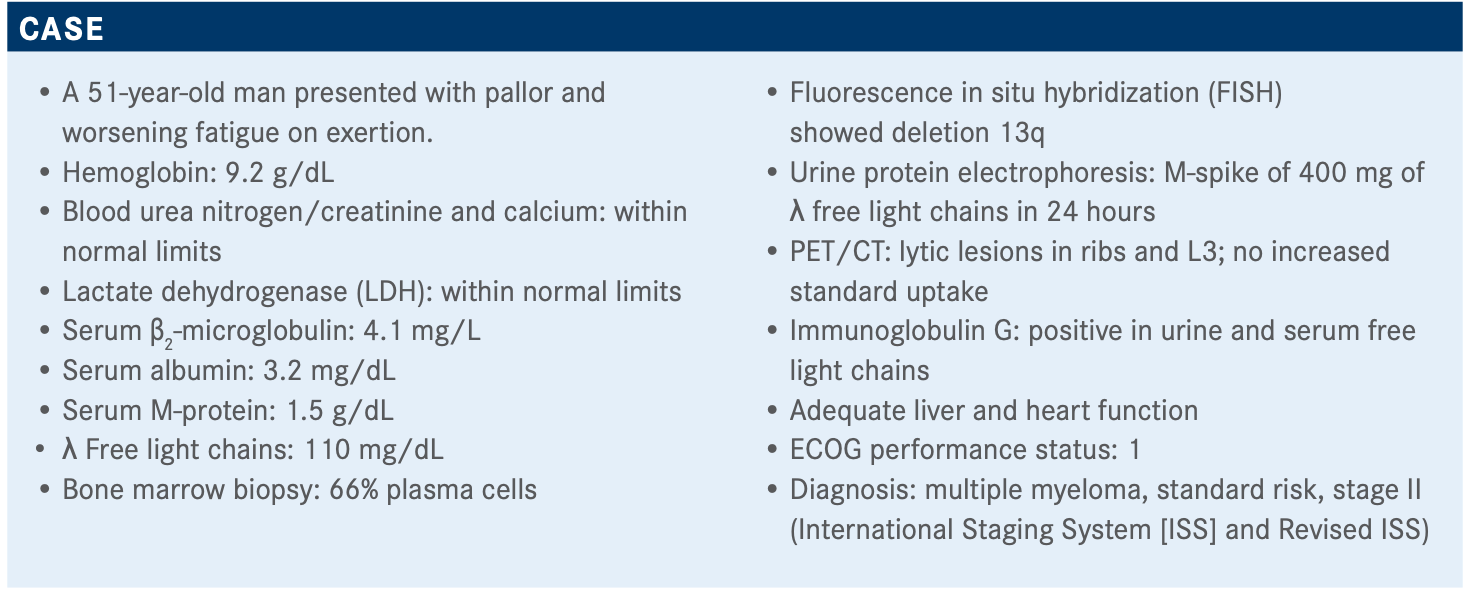Martin Explores Combination Regimens in Standard-Risk, Newly Diagnosed Multiple Myeloma
Thomas G. Martin, MD discussed the case of a patient with newly-diagnosed multiple myeloma during a virtual Targeted Oncology Case-Based Roundtable event.
Thomas G. Martin, MD

Thomas G. Martin, MD discussed the case of a patient with newly-diagnosed multiple myeloma during a virtual Targeted Oncology Case-Based Roundtable event.

Targeted OncologyTM: What factors make patients transplant eligible in this setting?
MARTIN: We don’t have an upper age of transplant at University of California, San Francisco. We will transplant anybody who we think is physically fit. It’s all about fitness. That said, the data [indicate that] as you get [patients] above age 70, the benefits start to narrow in terms of transplant versus no transplant or delayed transplant. For sure, for patients more than 75 years, we don’t have much data. We’re probably doing transplant to try to get the deepest possible remission.
Until recently, one of my referring physicians in San Francisco wasn’t doing β2-microglobulin [testing] because, he said, since it didn’t change the way he treats patients, [he didn’t do it,] in general, for patients with newly diagnosed multiple myeloma [NDMM]. But I would encourage [clinicians] to do the ISS and the Revised ISS for a number of reasons, including that current clinical trials are going to do eligibility based on the revised ISS. Currently, frontline chimeric antigen receptor T-cell trials...are [available] for patients with NDMM who have high-risk disease based on the revised ISS.
You have to have β2-microglobulin, LDH, albumin, and FISH [measurements] to be able to tell whether a patient has a Revised ISS stage III. That’s the only eligibility for those studies other than performance status.
This patient had a PET scan done. Do you routinely do PET scans for patients?
Yes, and I think that’s a great question. I think any patient with NDMM needs a scan that is not a bone survey. A bone survey does not tell much about what’s going on. The 3 potential scans [that tell more] are a low-dose whole-body CT scan, a whole-body MRI, or a PET/CT scan. I will do 1 of those 3 tests, [the choice] depending on what the insurance approves. I can’t guess with the insurances anymore. I start with [requesting approval for] the low-dose whole-body CT, and most of them will approve that. If I think the patient has bone disease—a lot of bone disease, and they have bone pain—I will also do a PET/CT scan to get a standardized uptake value.
What do you think of these poll results?
I’m shocked that everybody chose RVd [bortezomib (Velcade), lenalidomide (Revlimid), dexamethasone] for a standard-risk [patient]. That currently is the standard of care throughout the country based on a variety of [factors], but the transplant-eligible patient has other potential options.
How do the National Comprehensive Cancer Network (NCCN) guidelines suggest treating patients who are transplant eligible?

The NCCN guidelines essentially show quite a few regimens as potential treatment for patients with NDMM.1RVd has category 1 data. VCd [bortezomib, cyclophosphamide, dexamethasone] is also considered a preferred regimen, and maybe preferred in patients who have renal insufficiency...or [if] you want their kidney function to get better before you give them lenalidomide. Other options are KRd [carfilzomib (Kyprolis), lenalidomide, dexamethasone] and daratumumab [Darzalex] and RVd [dara-RVd].
Then, there are data using ixazomib [Ninlaro], lenalidomide, and dexamethasone as frontline therapy in the transplant-eligible and transplant-ineligible populations. The NCCN guidelines also list a whole variety of regimens that are useful in certain circumstances.
Recently, daratumumab was approved for use by subcutaneous injection. We’ve had very few problems switching patients from intravenous to subcutaneous daratumumab.
Can you describe some data looking at therapy with transplant versus without?
In the IFM 2009 [Intergroupe Francophone du Myélome 2009 (NCT01191060)] study, 700 patients were random-ized to RVd alone versus RVd plus transplant.2 The complete responses [CRs] were better in the transplant group. The very good partial response [VGPR] rate was about the same between the 2 arms. Partial response [PR] was a bit more in the RVd arm. But [RVd plus transplant gave] essentially a deeper response—more CRs [and PRs]—than RVd alone. [With transplant,] more patients achieved a minimal residual disease [MRD]–negative state.
The update at the 2020 American Society of Hematology [ASH] meeting [revealed that] at 8 years of follow-up, the overall survival curves between these 2 groups were completely superimposable.3 There was no difference in RVd frontline, with or without transplant. Then, 76.7% of patients who relapsed went on to get the transplant at relapse. So really, this was early versus delayed transplant. I thought these were pretty interesting data.
If we look at MRD at the start with daratumumab maintenance and after 1 year of maintenance, [we see that] the longer patients maintained MRD negativity, the better they did.4
Another trial, FORTE [NCT02203643], [looked at] KRd for 12 cycles versus KRd for 4 cycles, single autologous transplant, and then another 4 cycles.5 The primary end point was initially VGPR after induction, but then it was VGPR premaintenance. There was a second randomization in this trial to either lenalidomide by itself or carfilzomib plus lenalidomide as maintenance.
The data at ASH showed that at the start of maintenance, then following 12 months of maintenance therapy, more patients receiving maintenance-based therapy achieved MRD negativity in the lenalidomide/carfilzomib arm than in the lenalidomide-alone arm: Thirty-two percent of patients on lenalidomide went to MRD negative, and 46% on lenalidomide plus carfilzomib went to MRD negative.6
In the FORTE trial, [the rates of] stringent CRs were very similar [between the 2 arms], and VGPRs and MRD negativity were also similar.5 Early relapses were lower in KRd plus transplant versus KRd, 8% versus 17%, suggesting that a deepening of the response is important with transplant, even with using carfilzomib as frontline-based therapy.
The progression-free survival [PFS] from first randomization of KRd plus transplant versus KRd—and then KCd [carfilzomib, cyclophosphamide, dexamethasone] didn’t fare as well as the other 2 regimens.6 Looking at a subset analysis for ISS stage, FISH, and LDH, everything favored the KRd transplant over the KRd 12 arm.
From second randomization, if you break it up in subgroup analysis—ISS stage I versus ISS stage II or III, FISH standard versus high, and LDH upper limit of normal or below versus above upper limit of normal—all subgroups benefited from getting lenalidomide plus carfilzomib. Most [experts predicted that] just the high-risk patients would benefit, but the standard-risk and the high-risk patients benefited from getting lenalidomide plus carfilzomib versus lenalidomide.
How does the safety of lenalidomide plus carfilzomib compare with the safety of lenalidomide alone?
[The combination] was quite safe. The signal seen [most often was] the blood pressure signal. Not many cardiovas-cular events occurred, because these patients had already had 8 to 12 cycles of KRd and half of them had a transplant. So by the time they were done with 8 to 12 cycles, they were usually tolerating it really well. We saw no extra or worsening toxicity in those patients getting it as maintenance-based therapy, so [that’s] interesting.
Which trials looked at triplet versus quadruplet regimens?
The Cassiopeia trial [NCT02541383]...was with VTd [bortezomib, thalidomide (Thalomid), dexamethasone] versus VTd plus daratumumab, and then a second randomization to no maintenance versus daratumumab maintenance.7 [All patients received transplant before the consolidation phase.]
I really like this study. We could not do it in the United States. Apparently, they submitted the [updated] data to ASH for a late-breaking abstract, but too [many other research results] were already in the pipeline. We will see these data soon, at our next possible meeting, I [believe].
Suffice it to say that the stringent CRs...were higher [with daratumumab]. The 4-drug regimen did better than the 3-drug regimen. The MRD negativity rates were better and the PFS looked better [with daratumumab].
How did patients do with daratumumab in the United States?
In the GRIFFIN trial [NCT02874742], patients received daratumumab [with RVd] as frontline therapy induction for 4 cycles, then a transplant, then daratumumab and RVd for 2 consolidation cycles, and then daratumumab and lenalidomide maintenance.8 This was versus what we usually do—RVd, transplant, RVd, and then lenalidomide maintenance.
At the end of induction, the transplant consolidation, and then 12 months of maintenance, the greater-than-CR rate was huge [with daratumumab]. It was almost 82%, which is pretty amazing, versus 61% in the RVd-only arm.
The MRD negativity gets quite high, at 78% [with daratumumab] as you get into maintenance-based therapy, versus 39% in the RVd arm.
In a subset analysis, almost everybody benefited from getting the quadruplet regimen versus the triplet. The populations who didn’t seem to benefit as much were those with ISS stage III disease and those with high-risk cytogenetics. So, the question is: Is daratumumab plus RVd going to be the best thing for the patients with high-risk cytogenetics? I don’t think we know the answer to that question just yet.
The median PFS hasn’t been reached, but they’re projecting that the median PFS in the daratumumab/RVd arm may be upward of 70 to 80 months. That’s pretty long, 7 to 8 years; that’s crazy when we think about responses to induction-based therapy.
Investigators saw some blood count suppression when using daratumumab together with RVd, [as well as] more neutropenia and thrombocytopenia and mildly increased anemia.
Most of the other adverse effects were fairly similar, maybe a slightly increased risk of upper respiratory tract infections. The reason behind that is that they are becoming hypergammaglobulinemic. [Also,] the infusion-related reactions occur only in the daratumumab arm.
GRIFFIN is a phase 2 trial. Are any phase 3 trials looking at this regimen?
An international randomized phase 3 trial [NCT03652064] is accruing, to look at daratumumab and RVd versus RVd alone. Probably, that will lead to [this regimen’s] approval at some point.
REFERENCES
1. NCCN. Clinical Practice Guidelines in Oncology. Multiple myeloma, version 4.2021. Accessed February 16, 2021. https://bit.ly/36w3EKZ
2. Attal M, Lauwers-Cances V, Hulin C, et al; IFM 2009 Study. Lenalidomide, bort-ezomib, and dexamethasone with transplantation for myeloma. N Engl J Med. 2017;376(14):1311-1320. doi:10.1056/NEJMoa1611750
3. Perrot A, Lauwers-Cances V, Cazaubiel T, et al. Early versus late autologous stem cell transplant in newly diagnosed multiple myeloma: long-term follow-up analysis of the IFM 2009 trial. Blood. 2020;136(suppl 1):39. doi:10.1182/blood-2020-134538
4. Perrot A, Lauwers-Cances V, Corre J, et al. Minimal residual disease negativity using deep sequencing is a major prognostic factor in multiple myeloma. Blood. 2018;132(23):2456-2464. doi:10.1182/blood-2018-06-858613
5. Gay F, Cerrato C, Petrucci MT, et al. Efficacy of carfilzomib lenalidomide dexa-methasone (KRd) with or without transplantation in newly diagnosed myeloma according to risk status: results from the FORTE trial. J Clin Oncol. 2019;37(suppl 15):8002. doi:10.1200/JCO.2019.37.15_suppl.8002
6. Gay F, Musto P, Rota-Scalabrini D, et al. Survival analysis of newly diagnosed transplant-eligible multiple myeloma patients in the randomized Forte trial. Blood. 2020;136(suppl 1):35-37. doi:10.1182/blood-2020-136907
7. Moreau P, Attal M, Hulin C, et al. Bortezomib, thalidomide, and dexamethasone with or without daratumumab before and after autologous stem-cell transplantation for newly diagnosed multiple myeloma (CASSIOPEIA): a randomised, open-label, phase 3 study. Lancet. 2019;394(10192):29-3
8. doi:10.1016/S0140-6736(19)31240-18. Voorhees PM, Kaufman JL, Laubach J, et al. Daratumumab, lenalidomide, bort-ezomib, and dexamethasone for transplant-eligible newly diagnosed multiple myeloma: the GRIFFIN trial. Blood. 2020;136(8):936-945. doi:10.1182/blood.2020005288

Survivorship Care Promotes Evidence-Based Approaches for Quality of Life and Beyond
March 21st 2025Frank J. Penedo, PhD, explains the challenges of survivorship care for patients with cancer and how he implements programs to support patients’ emotional, physical, and practical needs.
Read More